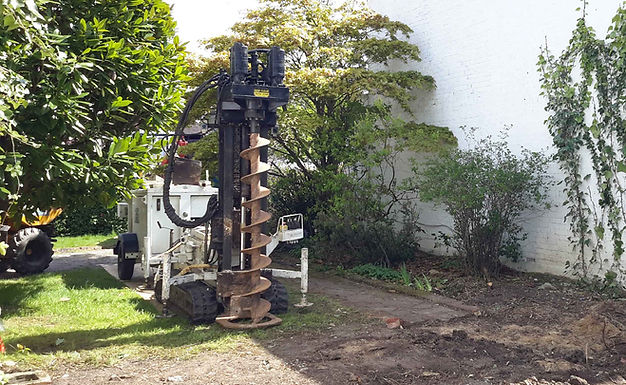HOME » SERVICES



Domestic and Commercial Piling Solutions
Whether you are private home owner, building contractor or developer, we can provide piling services for your next build.
From the design process right through to installation and completion we aim to offer a bespoke service which identifies a cost effective result for your project.
So whether you are just entering the design stage or are already prepared for piling to commence ASAP, we can help by offering our piling expertise and plant capabilities at every step.
What is Piling?
Piling is a method of creating deep foundations for a variety of structures in almost any ground type. Pile shafts can be constructed using concrete, steel, timber or a combination of these, such as with steel reinforced concrete piles.
Typically, the purpose of a piled foundation is to transfer loads from the ground level to a depth where a higher bearing capacity can be achieved. These solid columns are effective for building on sandy or unstable ground and for foundation works within close proximity to trees (where seasonal ground movement may present a hazard to foundations constructed on shallow ground).
Piles can also be employed to construct retaining walls and have been widely used in the UK civil engineering industry in recent years for the construction of basements where large excavations are required.

Mini Piling
Our Mini-piling equipment is particularly suited to working inside and around domestic properties, and in low headroom or tight access areas. This method of piling is ideal for work in locations where restricted access is an issue and the use of larger piling systems would be impossible.
CFA Piling
CFA piles are formed by drilling a Continuous Flight Auger into the ground. When the required depth is reached, concrete is immediately pumped into the hollow stem and the auger is slowly withdrawn (the sides of the hole are supported at all times by the soil filled auger). Reinforcement is then inserted immediately after the auger is removed. This is an ideal solution for unstable ground containing gravel, sand or silt.
Services
Latest Posts
Open Bored Piling
Open bored piles are formed when an auger is drilled into the soil in certain ground conditions where a stable open hole can be formed. In clay, for example, the augers can be removed and the bored hole can be filled with concrete, forming a pile. This method is ideal for use in cohesive soils. Our engineer will decide what type of Piling method best suits your needs upon a site inspection.
Ground Beams
It is common for projects that involve piling to use ground beams. Once piling is complete we can excavate the ground to a width and depth required or use shutters above ground as per design. Reinforcement is then placed and the pile reinforcement tied into the ground beam. After inspection by the relevant authorities the beam will be concreted, creating a solid base for block and brick works.
Concrete Slabs
RC slab or raft foundations are an alternative to ground beams where increased depth is a concern. The slab is excavated shortly after the piling work is completed, and layers of reinforced steel mesh are then placed on to the piles often above a layer of void former. The concrete is then poured and levelled providing a solid, even base to build upon.
Retaining Works
Retaining walls are created by installing a series of piles close together. These embedded piles create structurally sound walls for basement excavation. There are two main systems for creating retaining walls: contiguous bored pile walls and secant bored pile walls.
Contiguous Bored Pile Walls
This system is generally used for sites where groundwater is not an issue. The concrete piles are positioned so that they almost touch each other, leaving a gap of around 100mm between each pile, forming a robust retaining wall.
Secant Bored Pile Walls
This retaining wall system involves the installation of the piles in such a way that they overlap using a male and female pattern. This installation technique forms a watertight seal and thus provides a solid barrier against groundwater flow.
King Posts
King post walls are used for retaining ground where small settlements and ground movements are not critical to the project or the ground behind the retaining wall. A line of bored piles are installed with long steel H-Sections projecting from them. The gaps between the H-Sections are then filled with timber inserts such as sleepers or pre cast concrete planks.
Design and Calculation
Our in house engineers provide a full design and structural calculation service. We work closely with architects, local authorities, builders, and private clients to ensure the right design and most cost efficient method is selected to carry out their piling projects.
Piling Rigs
We have a range of piling rigs available to undertake the piling methods mentioned above. These include:
-
Mini Piling Rigs that can be operated in locations with tight access.
-
CFA Piling Rigs that allow piles to be concreted as they are augured.
-
SFA Piling Rigs that allow CFA capabilities with low headroom.
-
Screw Piling Drivers that range in size suitable for a variety of loads.
-
Driven Piling Rigs that can install bottom driven pile casings.



